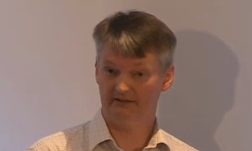Lecture Overview
In his first lecture, Dustin explains that adaptive immunity allows an individual to specifically recognize and respond to a vast number of molecules. B cells recognize intact antigens and produce neutralizing antibodies. T cells, on the other hand, have receptors on their surface that recognize very small antigen fragments bound to MHC on the surface of antigen presenting cells (APC). Dustin explains that T cells overcome the challenges of finding and binding to the APCs with the help of a multitude of adhesion molecules. Once the T cell receptor has bound a peptide antigen, an immunological synapse, with its typical bulls-eye structure, is formed resulting in T cell activation.
In Part 2, Dustin describes how a reconstituted system has allowed the immunological synapse to be studied in molecular detail. It is possible to visualize the localization of signaling molecules such as kinases, and determine the role of the actin cytoskeleton in regulating this localization. Dustin also touches on the role of the immunological synapse in autoimmune disease and cancer.
In his last lecture, Dustin presents work from his lab showing that T cell receptor enriched vesicles are generated in the immunological synapse. These vesicles can be transferred to B cells leading to activation of the B cells and, potentially, the production of higher specificity antibodies.
Speaker Bio
Michael Dustin is Professor of Immunology and Director of Research at The Kennedy Institute of Rheumatology at the University of Oxford. Prior to joining the Kennedy Institute, Dustin was a faculty member at the Skirball Institute of Biomolecular Medicine at New York University from 2001-2013 and at Washington University School of Medicine from 1993-2000. Dustin received his BA in Biology from Boston University and his PhD in Cell and Developmental Biology from Harvard University.
As described in his iBioSeminar, Dustin’s lab studies the molecular events that take place at the immunological synapse. Future research will focus on developing therapies targeted to the immunological synapse to cure chronic inflammatory illnesses such as rheumatoid arthritis.
Dustin is an active participant in the immunology community; he is a member of numerous grant review committees and journal editorial boards. His research has been recognized with many awards including the 2000 Presidential Early Career Award in Science and Engineering and the 2012 DART-NYU Biotechnology Achievement Award.
Medical and Patient education videos
-
Title
Description
-

This patient had severe kyphoscoliosis as a child with insertion of spinal rods in early adulthood. She is a life-long non-smoker. She first presented in 2001 with an irritating cough and several treatments with antibiotics failed to alleviate it.Aspergillus precipitin titre was high and she was initially diagnosed with chronic pulmonary aspergillosis with one cavity containing an aspergilloma. This patient developed resistance to all azole therapies.
-

Sources of aspergillus and how can I clean up at home? By Professor Malcolm Richardson
-

Informal recording of a meeting for patients. By Philip Langridge Aspergillosis Specialist Physiotherapist.
-

Simple steps for patients to loosen phlegm in the lungs and easily produce sputum samples for testing in the clinic. Designed for aspergillosis patients or any patients with respiratory illnesses.
-

A double lung transplant has been carried out on a young cystic fibrosis patient, who had more than 10 aspergillomas in her lung. Clip shown on BBC North West news shows an interview with Becky and Prof Denning.
-

Short history from patient’s wife. Brief history and experiences of attending National Aspergillosis Centre
-

Immunodiffusion technique to test for serum antibodies in patients – describes how to set up a test for the presence of antibodies in serum which are specific to various fungal pathogens. The technique is used to test and measure titres of these antibodies in the serum of infected patients.
-

21-year-old medical student Jo Armstead has made a major discovery, which will help doctors better able to diagnose and treat patients with Cystic Fibrosis (CF). Jo spent hundreds of hours accessing data from 30 countries to discover that there are over 75,000 people with the genetic disorder, of whom half are over 18 years – with 50 per cent infected by the fungus, Aspergillus. Professor David Denning, Director of the NHS National Aspergillosis Centre and Professor of Infectious Diseases in Global Health at the University of Manchester explains: “The life expectancy of people with CF has been increasing, but aspergillosis has a major negative impact on many. By painstakingly crunching the numbers, Jo has helped us better understand the scale of the challenge which will lead to better diagnostics and treatment strategies.” Prof Denning and Jo were interviewed on BBC-1 Breakfast last Sunday June 29th.
-

Literary event – Manchester Literature Festival hosted at Manchester Museum to increase awareness of Aspergillosis, in October 2013. Exploring literature, music and medicine.
-

Fungi are eukaryotic organisms which possess a unique cell wall and cell membrane that can serve as targets for antifungal agents. The echinocandin class of antifungal agents target the cell wall of fungi. Watch this animation for more information.
